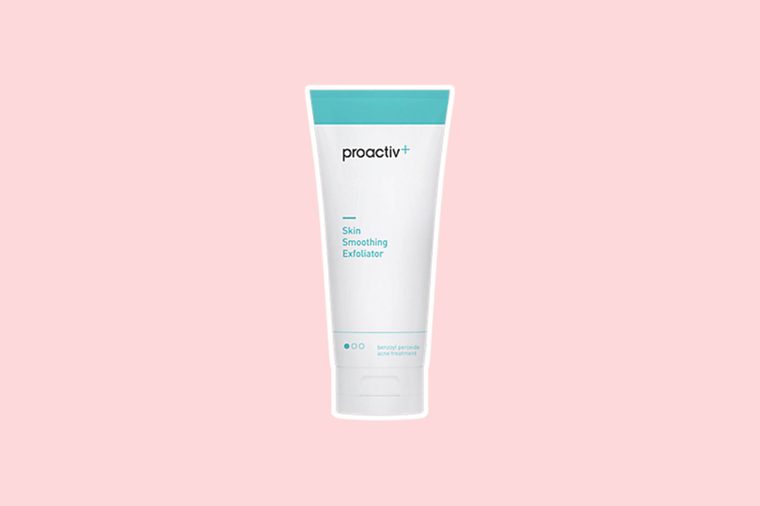There are two types of exfoliators
There are many skincare tips dermatologists use on their own skin, and one of them is regular exfoliation. Exfoliation means removing surface dead skin cells, and there are generally two ways to go about it. “Chemical exfoliants essentially dissolve the glue holding the unwanted dead skin cells on, while physical exfoliants mechanically remove them by rubbing or abrading them off,” explains Neal Schultz, MD, NYC dermatologist, host of DermTV.com, and creator of BeautyRx by Dr. Schultz. Dr. Schultz and NYC-based dermatologist and founder of the skincare line, Dennis Gross, MD, both prefer chemical exfoliation. “Peels and acids are an anti-aging staple because they provide both instant and long-term results,” says Dr. Gross. “Acids immediately remove old, dull skin, exfoliate, rejuvenate, brighten, and make skin appear younger. In the long-term, acids stimulate collagen, revealing younger, more radiant skin over time.” Try the Dr. Dennis Gross Skincare Alpha Beta Medi–Spa Peel. (Here’s a look at what else you need to get glowing skin in just one month.)
$153 at Amazon
The best chemical exfoliator
While our dermatologists agree that chemical is the way to go, there are a variety of chemical exfoliants to choose from. According to Dr. Schultz, the gold standard in superficial peeling agents is glycolic acid, a type of alpha-hydroxy acid and one of the best skincare ingredients for fighting acne. “When properly formulated and applied, it gives you smoother, brighter, more even-toned, smaller-pored, younger-looking skin—with no downtime, no redness, no irritation,” says Dr. Schultz, who has offices in Manhattan. He also underlines that chemical exfoliation gives much better, consistent, and predictable results than any form of physical exfoliation because the outcome of physical exfoliation depends on three variables that are never the same: How much pressure or how hard you rub, how long you treat any given area and the lack of uniformity of the physical exfoliating medium—basically the consistency of the granules or loofah may not be even.
Other popular chemical exfoliators are the alpha hydroxy acids lactic acid, citric acid, and mandelic acid, plus a beta hydroxy acid, salicylic acid. Though there are subtle variations in how they work, they all increase cell turnover, which is the ultimate goal of exfoliation. (These are the exfoliation ingredients you need to know about.)
$27.99 at Amazon
The best exfoliator for combination skin
Glycolic acid is the go-to in this case since it can work safely and effectively on both oily and dry skin. “It’s water-soluble, so it doesn’t travel into the pore as much as oil-soluble salicylic acid, but it can still remove oil from the surface of the skin and exfoliate dead cells just as well, making it a great option for combination skin,” explains Dr. Zeichner, who recommends SkinCeuticals Purifying Cleanser. Alpha Beta Extra Strength Daily Peel is also a good option in this case since you’re targeting your skin with a cocktail of several acids. “The blend of seven different acids such as lactic, mandelic, glycolic will target different concerns for those with a range of skin issues,” explains Dr. Gross. (Here’s how often you should exfoliate your face for the best results.)
Shop Now
The best exfoliator for thick skin or large pores
This is the one case where Dr. Schultz would recommend considering physical exfoliation or exfoliating with a gentle chemical exfoliant like 5% glycolic acid. If you opt for the physical exfoliant, use a loofah type sponge to massage in circular motions with gentle pressure for a few minutes. Lubrication with a gentle cleanser will help avoid irritation. “Try using a cleanser with exfoliating granules, but make sure you choose one with round or smooth granules, not one with sharp, hard, or angular particles like crushed nutshells, which can be too abrasive and damage skin,” Dr. Schultz says. Try Proactiv+ Skin Smoothing Exfoliator. (Make sure to avoid these other exfoliation mistakes that could sabotage your skin.)
Shop Now
The best exfoliator for mature skin
A great exfoliator for mature skin, which is thin, dry, and weaker than young skin, is lactic acid, a type of alpha-hydroxy acid, according to Dr. Zeichner, since it can hydrate even as it exfoliates. “Lactic acid has also been shown to strengthen and actually thicken the skin foundation.” Try Dr. Brandt Skincare Microdermabrasion Age Defying Exfoliator, which also contains the botanicals jojoba, aloe vera, and chamomile to soothe skin. (Just be wary of how your phone can age your skin!)
$57.92 at Amazon
The best exfoliator if you have rosacea
“People with rosacea have very sensitive skin so any type of physical exfoliation is going to be potentially irritating,” says Dr. Schultz, who recommends a gentle chemical exfoliant in a low concentration, like a 5% glycolic. First, test it on the front of your ear for two or three days in a row, and if there’s no irritation, you can start to put it on your whole face. “However, I would apply it only on your whole face every third or fourth night in the beginning, and then gradually, over a period of weeks, you can increase the frequency.” First Aid Beauty Facial Radiance Pads are particularly gentle. While you’re at it, check your diet and make sure to avoid the foods that can make rosacea worse.
$36 at Amazon
The best exfoliator for sensitive skin
If you have truly sensitive skin, which Dr. Schultz defines as irritated by many common skincare ingredients, then opt for products featuring lactic acid, which is less potent than acids such as glycolic and salicylic. Try Sunday Riley Good Genes, and mind the rules you must follow if you have sensitive skin.
85.0020% OFF$68 at Amazon





























